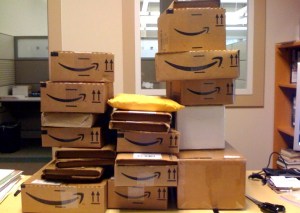Michael Hart is VP of Logistics at start-up Deliv.
Do you remember the days when needing something delivered “absolutely positively overnight” felt like it was pretty efficient?
In my world, the next day may as well be the next decade. Shoppers are demanding faster and faster delivery on the items they order online, and organizations like Amazon and eBay have conditioned them to think that’s reasonable.
And you know what? It is.
 There is no reason why a retailer should hold your money for days while you wait around for UPS, FedEx or whoever to get it to you. More often than not, the item only has to travel less than 10 miles … why on earth should that take three days? Or worse, why should it cost more just for the convenience of having it sooner.
There is no reason why a retailer should hold your money for days while you wait around for UPS, FedEx or whoever to get it to you. More often than not, the item only has to travel less than 10 miles … why on earth should that take three days? Or worse, why should it cost more just for the convenience of having it sooner.
When I read reports suggesting consumers aren’t really interested in same-day delivery, I wonder whether the same people thought faxes were simply too fast. Or that people in restaurants should serve their own food. A delay in demand and outcry isn’t a sign that the benefit won’t someday become the mandatory minimum.
Wasn’t it Steve Jobs who argued that “people don’t know what they want until you show it to them?”
Same-day delivery anticipates the delight that it brings to consumers, and the precious competitive edge some retailers have by investing in it. In the future it will be unthinkable to lack such a service.
Same-day delivery is about a simple premise: Give customers an outstanding experience and they will come back. Part of an outstanding experience is convenience, another part is affordability. This approach is also the key to industry disruption. Partnering same-day delivery with equal cost to other delivery options is a one-two punch against the status quo of delivery delay that consumers resent today.
Amazon, where I used to work, disrupted ecommerce and used delivery as the weapon.
The company’s adoption of same-day delivery helped it capture a massive chunk of the $350 billion online retail market, much of it by offering the convenience of clicking online and having the product delivered on the same day. We’ve seen the success as customers flock to this example of a convenient and personalized-service retailer, leaving many brick and mortar stores in their dust.
Now, with Internet giants Google and eBay and a raft of startups, including mine, joining Amazon in the world of same-day delivery, the big winners will be the shoppers. As same-day delivery shifts from a premium price to the same price as standard, demand will increase, volume will increase and costs may even come down further. More great news for consumers – better service, lower prices.
But what about traditional retailers? Are the same poor folks who saw their margins and volumes disrupted by Amazon and others about to be hammered again?
Here’s the twist: Those retailers who have retained their national chain of stores and built a web/mobile presence are actually in the box seats. Organizations like Sears and Walmart have inventory within five miles of 95 percent of the American population via their brick and mortar stores. In the literal race to get packages to shoppers, this actually puts them at a massive advantage over the online-only players which typically have either state-based or regional-based distribution centers.
Could same-day delivery, the very thing that helped Amazon become the $130 billion retail giant it is today, be the very same thing that helps traditional retailers fight back? If so, the answer to who really wants same-day delivery is not just the shoppers.
 Michael Hart is VP of Logistics at start-up Deliv, and has more than 15 years of progressive supply chain and logistics operations. He comes to Deliv from Amazon where he helped build the company’s same-day delivery service.
Michael Hart is VP of Logistics at start-up Deliv, and has more than 15 years of progressive supply chain and logistics operations. He comes to Deliv from Amazon where he helped build the company’s same-day delivery service.


